Fort Pierre, South Dakota is nestled along the banks of the Missouri River. It is a vital town for the community but is also a testament to the history of South Dakota. Founded in 1832, this venerable town has a heritage that spans centuries. This is visible in its well-preserved landmarks and the stories that are visible as one walks through its streets.
Origins of Fort Pierre, South Dakota
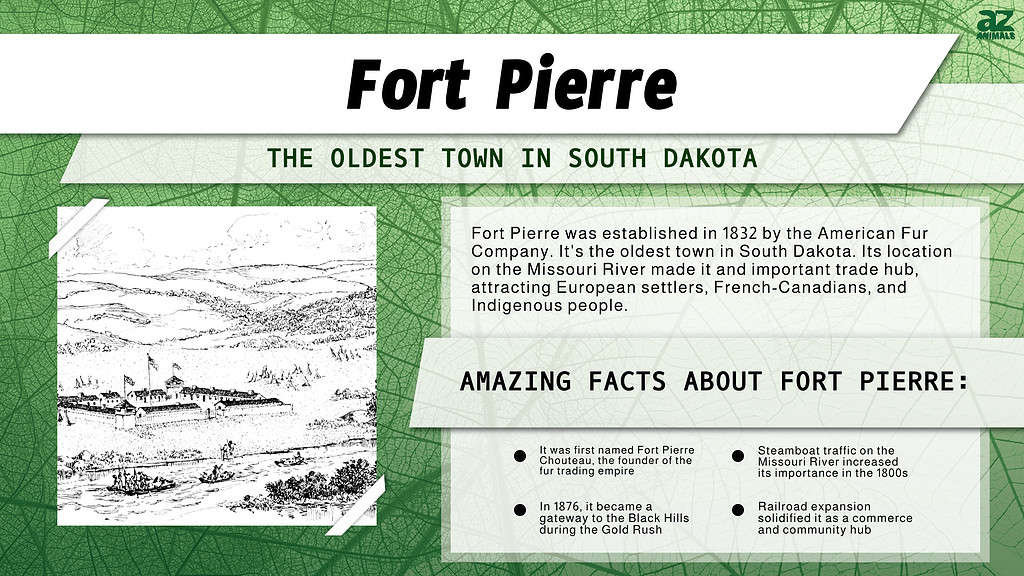
As mentioned earlier, Fort Pierre is a living testament to the history of South Dakota. Its origins are deeply intertwined with the early days of westward expansion, the fur trade, as well as interactions between indigenous communities and European settlers.
Early Days and Fur Trade Roots
Fort Pierre’s history goes all the way back to the early 19th century. The American Fur Company established a fur trading post at the confluence of the Missouri and Bad Rivers in 1828. The post was named Fort Pierre Chouteau in honor of Pierre Chouteau Jr., the founder of the fur trading empire. It served as a vital link in the fur trade network that soon spanned the continent. The location was strategically chosen due to its proximity to the Missouri River. This proximity provided access to the vast fur-bearing territories of the West.
The fort quickly became a hub of activity, drawing trappers, traders, and indigenous populations to its bustling trade. The establishment of Fort Pierre facilitated the exchange of goods, furs, and cultures. This made it a crossroads of commerce and interaction. The fur trade era also brought together individuals from diverse backgrounds. This includes French-Canadian trappers, Lakota Sioux tribes, as well as European traders.
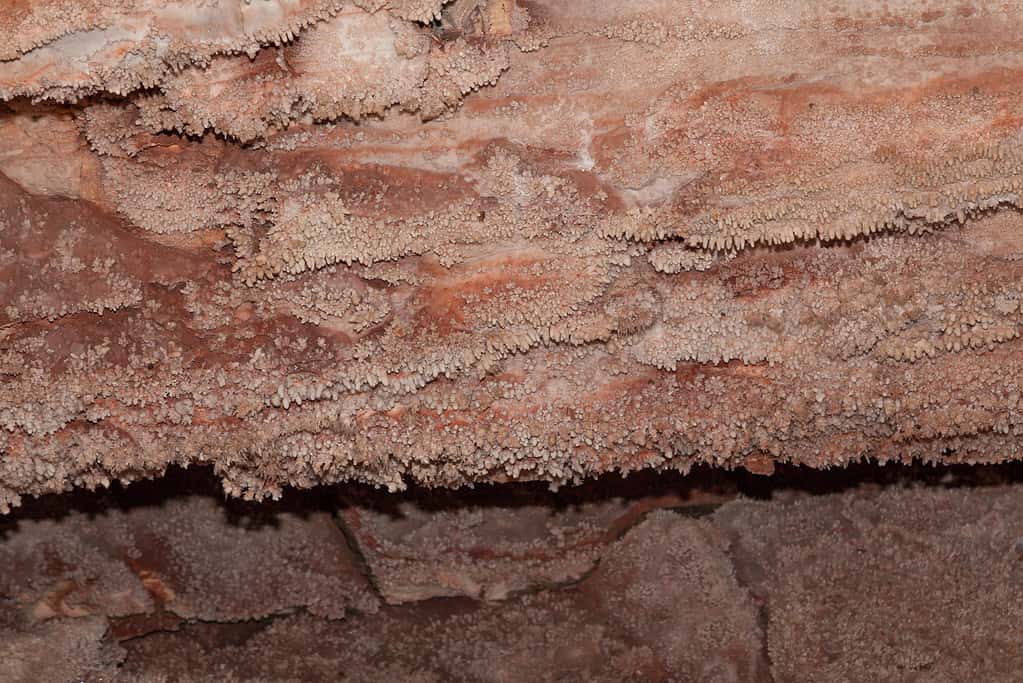
A detailed section of frostwork and popcorn-style cave features are visible at Wind Cave National Park, South Dakota.
©Tami Freed/Shutterstock.com
Pivotal Role in the Fur Trade
During the mid-1800s, Fort Pierre became even more significant as steamboat traffic along the Missouri River increased. The fort served as a vital supply point and stopping place for steamboats traveling up and down the river. This strategic position ensured that the fort remained a focal point for trade and interaction between the eastern United States and the emerging frontier territories.
The fur trade, while shaping the economic landscape of Fort Pierre, also influenced its cultural dynamics. The interactions between indigenous communities and European traders brought about an exchange of traditions, languages, and goods. These interactions, while often complex, contributed to the development of the unique cultural identity of the town.
Gold Rush and Westward Expansion
Fort Pierre’s history was also impacted by the Gold Rush of 1876. During this time, there was an influx of prospectors and settlers into the Black Hills of South Dakota. As adventurers headed west in search of gold, Fort Pierre became a gateway to the mineral-rich hills. Therefore, the town played a crucial role in supporting those venturing into the Black Hills.
The establishment of railroads and the westward expansion of the United States continued to shape Fort Pierre’s history. Settlers pushed further into the frontier. So, the town evolved from a fur trading post into a hub of commerce and community. The establishment of infrastructure, including schools, churches, and businesses, marked the transition into a settled town. However, Fort Pierre still retained its historical roots while embracing this progress.
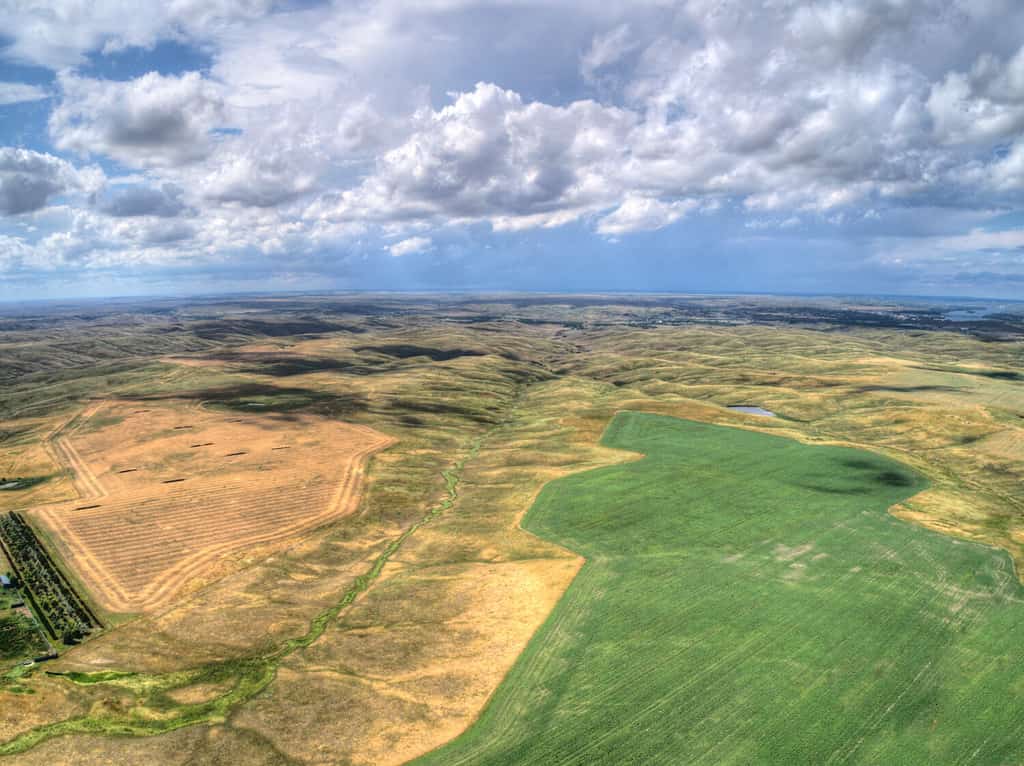
Fort Pierre National Grassland is located in Central South Dakota.
©Jacob Boomsma/Shutterstock.com
Preservation and Legacy
Today, Fort Pierre remains a living monument to its storied past. The historic buildings, including the Governor William J. Bulow House and St. Peter’s Episcopal Church, remind the townsfolk of the early days. The preservation of these landmarks reflects the community’s commitment to honoring its heritage. They also ensure that the stories of those who shaped Fort Pierre are passed down to future generations.
Visitors to Fort Pierre can also explore the Verendrye Monument, a tribute to the French explorers who ventured into the region in the 18th century. The monument, erected in 1913, pays homage to the individuals whose journeys paved the way for future settlers and traders.
Geographical Context: Where Fort Pierre Finds Its Place
Situated along the banks of the majestic Missouri River, the town is both historically significant and ecologically diverse.
Confluence of Waters: The Mighty Missouri River
The Missouri River, known as the “Big Muddy,” winds its way through the heart of Fort Pierre, bestowing the town with a vital lifeline and a sense of connectivity. As the longest river in North America, the Missouri River played a central role in the exploration, settlement, and trade routes of the American West. Its waters have witnessed the passage of indigenous tribes, fur trappers as well as pioneers.
The river’s presence, therefore, has always been integral to the town’s identity. It not only provides a source of water, but also serves as a recreational haven for fishing, boating, and water-based activities. The picturesque riverbanks also invite residents and visitors to bask in the tranquility of the flowing waters and offer an escape from the bustle of everyday life.

The Big Bend Dam on the Missouri River is located near Fort Thompson, South Dakota.
©Harry Weddington, U.S. Army Corps of Engineers / This image or file is a work of a U.S. Army Corps of Engineers soldier or employee, taken or made as part of that person’s official duties. As a work of the U.S. federal government, the image is in the public domain. – Original
Vast Plains and Expansive Skies
The Great Plains extend far and wide around Fort Pierre. Thus, they create landscapes filled with endless horizons and expansive skies. The rolling prairies, adorned with native grasses and wildflowers, present a serene canvas that seems to stretch on indefinitely. This landscape of openness fosters a sense of freedom and connection with nature that is synonymous with the American West.
The vastness of the plains allows for unobstructed views of the sunrise and sunset. Here, the sky is transformed into a brilliant tapestry of colors. It therefore becomes a place where storm clouds gather dramatically and shower rain, and where the stars sparkle with unparalleled brilliance on clear nights.
Gateway to Natural Wonders: Proximity to Pierre and Beyond
Fort Pierre’s proximity to the state capital, Pierre, and its surroundings also gives it a layer of added significance. Together, the two cities form a dynamic duo that showcases the fusion of history and modernity within the state of South Dakota. While Fort Pierre echoes the past with its preserved landmarks and heritage, Pierre represents the present and future with its governmental functions and contemporary amenities.
Fort Pierre’s location also makes it a gateway to the natural wonders that South Dakota offers. The nearby Badlands National Park, with its striking geological formations and unique landscape, beckons adventurers to explore its surreal terrain. The Black Hills, with attractions like Mount Rushmore and Custer State Park, also provide opportunities for hiking, sightseeing, and generally experiencing the allure of the American West.
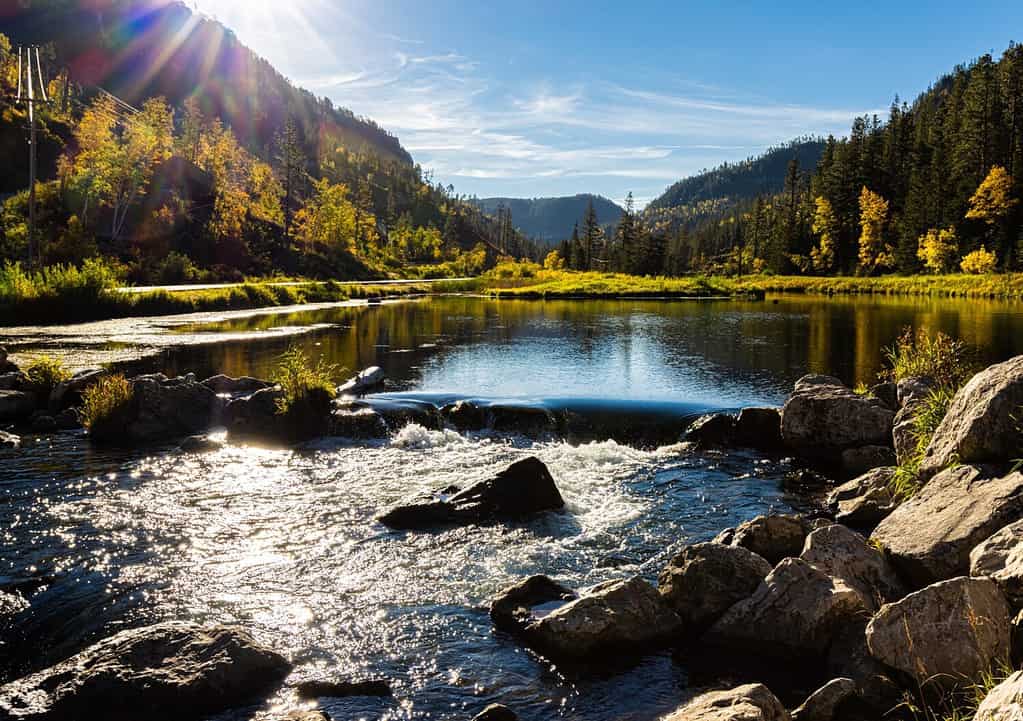
Spearfish Creek Dam and Savoy Pond are located in Spearfish Canyon State Natural Area in South Dakota.
©Billy McDonald/Shutterstock.com
Embracing the Wild: Biodiversity and Wildlife
Fort Pierre’s geography supports a rich tapestry of biodiversity, making it a haven for wildlife enthusiasts and nature observers. The convergence of the Missouri and Bad rivers creates diverse riparian habitats that attract a variety of bird species, mammals, and aquatic life. The surrounding prairies and hills also provide homes for creatures both large and small, from bison to songbirds.
The town’s position along the Missouri River also plays a role in shaping its ecosystem. Riparian areas are known for their ecological importance, as they provide critical habitat for both resident and migratory species. The interaction between water and land creates a dynamic environment that supports a delicate balance of life. This makes Fort Pierre a hotspot for those seeking encounters with the natural world.
Climate of Fort Pierre, South Dakota
Since it is situated in central South Dakota, Fort Pierre experiences a continental climate characterized by distinct seasons and notable temperature fluctuations.
Summers in Fort Pierre bring warmth and sunshine, with average high temperatures ranging from the mid-80s to low 90s degrees Fahrenheit (29-35°C). The region experiences a noticeable increase in humidity during these months, which creates a sultry atmosphere. Thunderstorms are not uncommon during the summer either. They provide much-needed rainfall for agriculture and the surrounding natural landscapes. The lush greenery and blooming flowers also contribute to the area’s visual appeal. Meanwhile, ranching and farming keep the region economically nourished.
As summer gives way to fall, the climate gradually transitions to cooler temperatures. The air becomes crisper, and the foliage transforms into vibrant shades of red, orange, and gold. Autumn in Fort Pierre gives residents and visitors the chance to witness the breathtaking beauty of nature’s changing palette. Average high temperatures in fall range from the mid-50s to low 60s in degrees Fahrenheit (13-17°C), creating a comfortable atmosphere for outdoor activities and seasonal celebrations.
Winter and Spring
Winter brings a dramatic shift in weather to Fort Pierre. The months of December through February are characterized by very cold temperatures, with average high temperatures ranging from the mid-20s to low 30s in degrees Fahrenheit (-4 to 1°C). Therefore, snowfall is very common and covers the landscape in a picturesque blanket of white. The cold weather often necessitates warm clothing and heating systems to combat the chill. However, despite the frigid temperatures, the snowy landscapes also create opportunities for winter sports enthusiasts. They also bring along a serene beauty that captures the essence of the season.
Finally, spring comes along as a season of renewal and transformation. Average temperatures gradually climb into the mid-40s to low 60s Fahrenheit (7-17°C), thawing the frozen landscapes and signaling the return of greener life. Blooming flowers, budding trees, and the return of migratory birds rejuvenate the region. Spring rains also replenish the land after the cold winter months, supporting agricultural activities and enhancing the area’s natural beauty.
Where Is Fort Pierre Located on a Map?
Fort Pierre sits in Stanley County, South Dakota, located in the center of the state. It borders the Missouri River to the west, while the town of Pierre lies on the opposite bank. The region has interesting geographical areas such as the Cheyenne River Reservation in the north, the Crow Creek Reservation to the southeast, the Rosebud Indian Reservation to the south, and Badlands National Park to the west.
Wildlife You’ll Find in Fort Pierre
The natural splendor in Fort Pierre provides a haven for a diverse array of wildlife. It also offers nature enthusiasts and wildlife observers a unique opportunity to connect with the region’s fauna. Whether exploring the banks of the Missouri River or venturing into the surrounding prairies, Fort Pierre’s ecosystem boasts a variety of species that thrive within its boundaries. Some of them are highlighted below:
1. Bison — Guardians of the Prairie
Bison, often referred to as American buffalo, are an iconic symbol of the Great Plains. The nearby Cheyenne River Sioux Tribe’s buffalo herd, one of the few genetically pure herds in the country, roams freely across the prairies. This scene evokes a sense of reverence for these majestic creatures, especially because of their historical significance within many Indigenous cultures.

Bison, or American buffalo, are native to the Great Plains and Fort Pierre.
©Grey Mountain Photo/Shutterstock.com
2. Birds of Prey — Masters of the Skies
Fort Pierre’s open landscapes are a haven for birds of prey, including the bald eagle and the golden eagle. These regal raptors command the skies. Meanwhile, their sharp eyesight and graceful flight patterns show their mastery of the ecosystem.
3. Waterfowl — A Symphony of Colors
The Missouri River serves as a vital migratory route for waterfowl. From Canadian geese to various species of ducks, the riverbanks come alive with the mesmerizing sights and sounds of migrating birds.
4. Deer and Antelope —The Graceful Residents
The prairies and river valleys are also home to mule deer and white-tailed deer, both graceful creatures that adapt seamlessly to their surroundings. Additionally, the pronghorn, a symbol of the American West, can often be spotted in the open expanses.
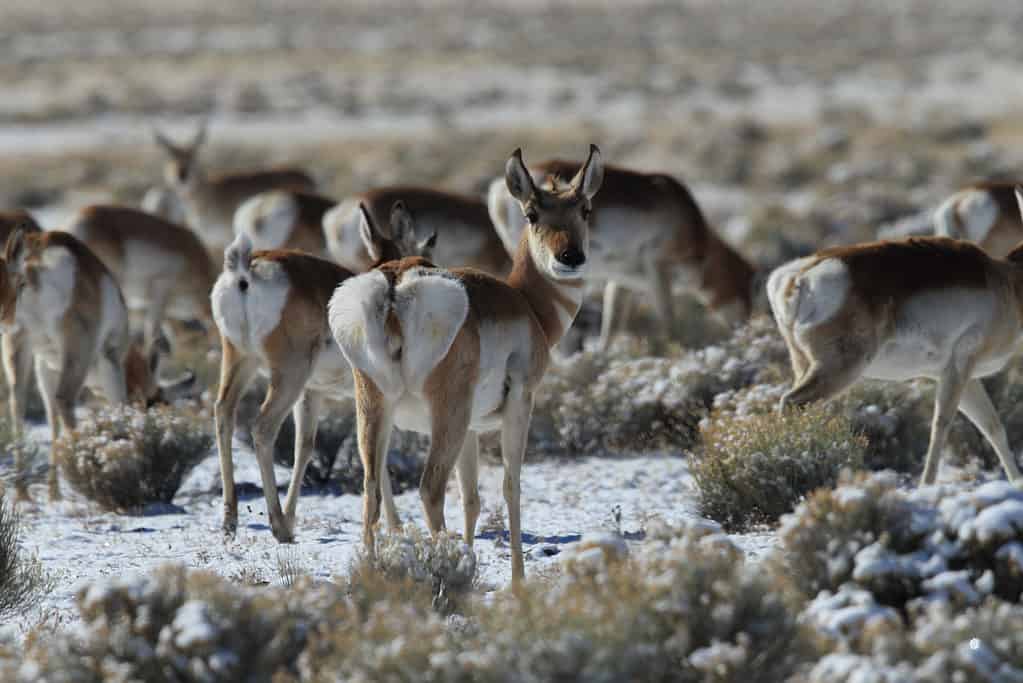
When a pronghorn sees a predator, it raises its white rump hairs. Other pronghorns will notice the white patch as a warning sign and flee.
©Greens and Blues/Shutterstock.com
5. River Otters — Playful Natives
The Missouri River and its riparian habitats also provide a home for river otters, who are known for their playful behavior and streamlined movements through the water.
6. Prairie Dogs — The Architects of the Prairie
The prairie dog also plays a vital role in maintaining the health of the grassland ecosystem. Their intricate burrow systems create shelters for various other species. This also showcases the interconnectedness of life within the prairie.
7. Coyotes — The Resilient Predators
The adaptable coyote, a symbol of resilience and survival, roams the plains of Fort Pierre. Its distinctive calls echo across the landscape and are very much a part of Fort Pierre’s identity.
8. Songbirds — Nature’s Melodious Performers
Fort Pierre’s diverse habitats attract a variety of songbirds, each adding their unique melody to the prairie chorus. From the western meadowlark‘s cheerful trill to the haunting calls of the Eastern screech owl, the avian residents contribute to the symphony of nature in Fort Pierre.
9. Elk – Majestic Wanderers
While not as common as other species, elk can sometimes be spotted near the river valleys and wooded areas surrounding Fort Pierre. Their imposing presence and imposing antlers make them a captivating sight for those fortunate enough to encounter them.

This beautiful elk stands majestically in a meadow, surveying its surroundings.
©iStock.com/Matt Kaminski
10. Reptiles and Amphibians — Hidden Treasures
Fort Pierre’s ecosystem also harbors a variety of reptiles and amphibians, including snapping turtles, painted turtles, and various frog species. These often-overlooked creatures play vital roles in the ecosystem’s health and balance.
In conclusion, Fort Pierre, the oldest town in South Dakota, offers not only a glimpse into the past but also a doorway to the vibrant natural world that surrounds it. As you explore its historic streets, engage with its heritage, and embrace the tranquility of its natural landscapes, you’re also invited to encounter the remarkable wildlife that calls this region home.
Being such, it acts as a bridge between generations and as a gateway to the diverse and enchanting ecosystems of the Great Plains. Thus, the town embodies the spirit of exploration and discovery that defines the American experience.
The photo featured at the top of this post is © PeterHermesFurian/iStock via Getty Images
Thank you for reading! Have some feedback for us? Contact the AZ Animals editorial team.







